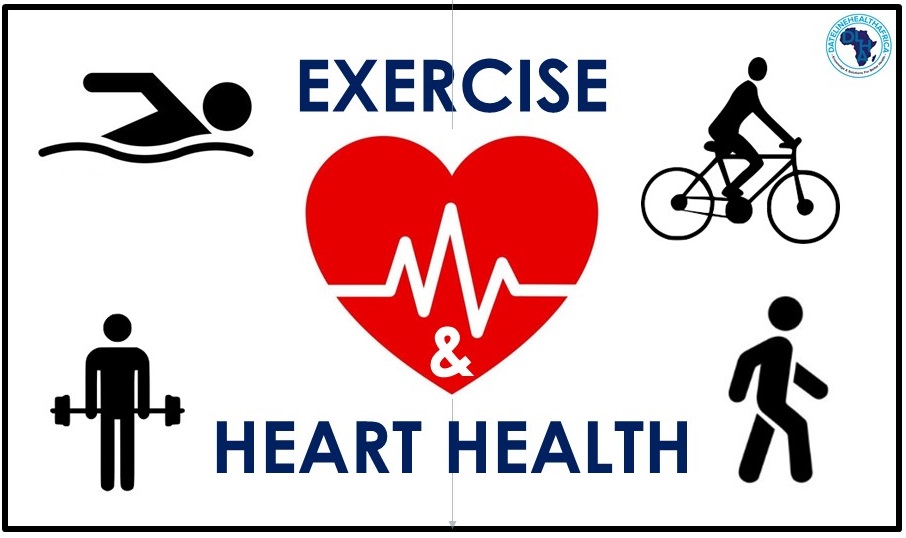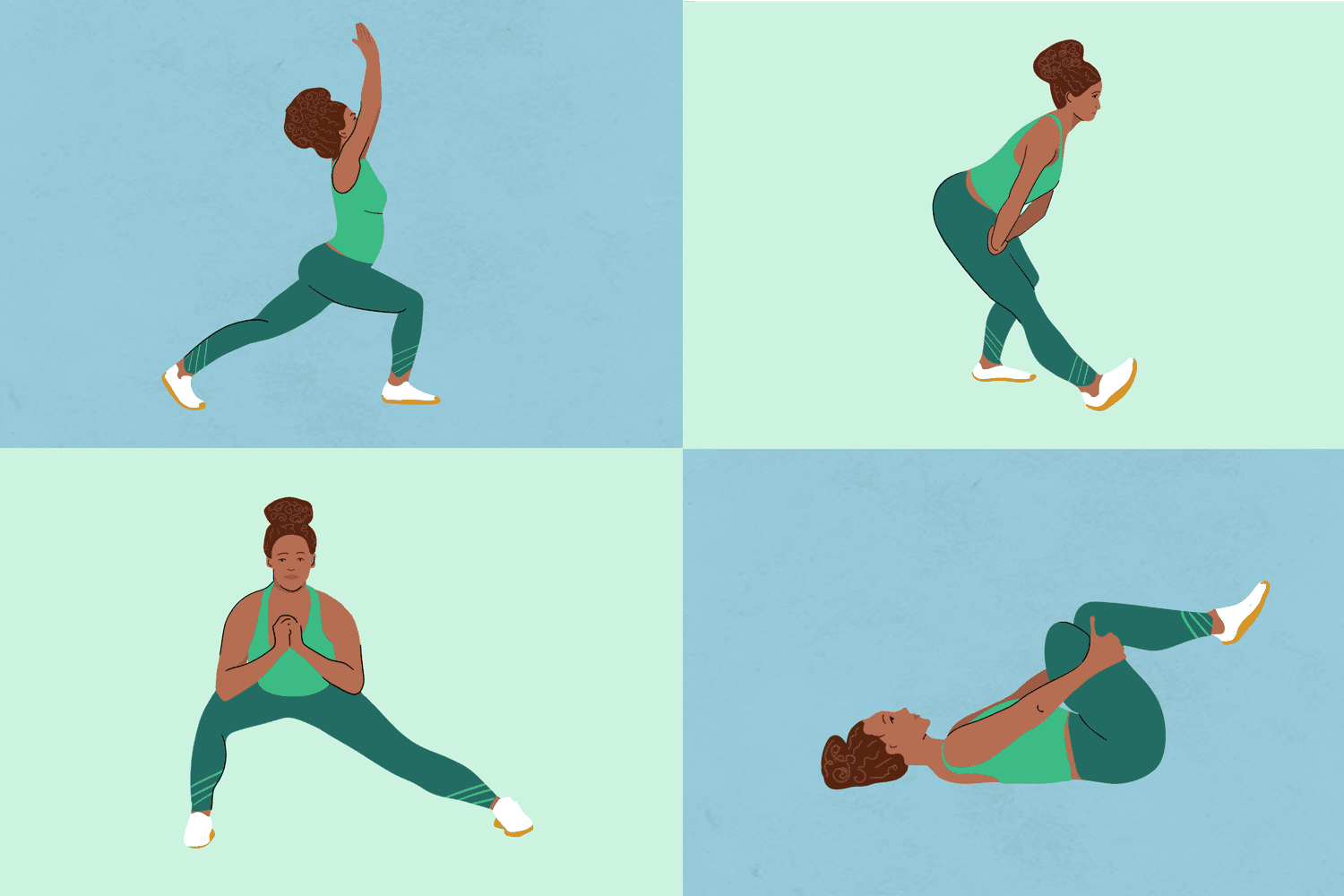By Ogechi Obi. Freelance Health Writer and Datelinehealth Africa Volunteer with medical review and editorial support by The DLHA Team.

Highlights
The idea that exercise is good for heart health is supported by clear scientifc evidence.
It works directly and indirectly to protect and improve the proper functioning of the heart. It also helps in preventing and reducing several risk factors for cardiovascular diseases, like
Cardiovascular diseases are becoming increasingly common in low and middle income countries. Consequently, lifestyle modifications such as exercise have been advocated as effective ways to prevent these diseases and improve health.
One may therefore ask, is exercise good for heart health?
Many quality studies exist especially in the global north that allow a confident and positive response to the question. Yes, exercise provides many tangible benefits to heart health.
Exercise protects the heart by preventing the development of risk factors for heart disease, including obesity, sedentary lifestyle, high blood pressure, atherosclerosis, and diabetes mellitus.
Several aerobic exercises, flexibility training, and moderate resistance training have shown promising results.
This article will:
Exercise benefits heart health in so many ways that are direct and indirect.
Exercise also aids heart health indirectly through other complex mechanisms that includes:
The combined effects of these direct and indirect benefits of exercise on heart health is the reduction of the risk factors for cardiovascular diseases like hypertension, heart attack, cardiac arrest, stroke and many others.
Exercise benefits heart health in the ways discussed below and summarised in Table 1.
Body weight and body fat are among the risk factors for heart disease.
Your risk of cardiovascular diseases increases with increasing body mass index (BMI) and waist circumference – more than 35 inches for women or more than 40 inches for men.
The ideal body weight is 18.5 and 24.9 kg/m2. Excessive weight can cause buildup of fatty deposits in blood vessels and increase blood pressure. It also increases the workload of the heart as it pumps blood to an overweight and obese body.
Physical activity helps to support the maintenance of body weight once weight is lost through other additional means like a healthy diet. This in turn reduces the odds of you developing diabetes and hypertension and their resultant effect on the heart. Exercise combined with a healthy weight therefore contributes to improving your heart health.
A large population based study (8) indeed confirmed this viewpoint as it showed that being physically active provided clear benefits to heart health in people who maintain a healthy weight than in those who are overweight or obese.
You should therefore aim at weight loss, which can be achieved effectively with exercise combined with a good diet plan.
A high blood pressure is one of the important risk factors for cardiovascular diseases and is mostly associated with no symptoms.
This means that you may be unaware that you have high blood pressure and consequently be silently at risk for serious cardiovascular diseases, including stroke and heart disease.
Moderate to high intensity exercise can help to lower and prevent rise in your blood pressure.
Researchers have proposed various mechanisms through which physical activity prevents hypertension.
.jpg) A study (7) showed that in a healthy person, exercise training causes a general adjustment of the arterial wall and improves its elasticity. In so doing, arterial vessel resistance drops and so does blood pressure.
A study (7) showed that in a healthy person, exercise training causes a general adjustment of the arterial wall and improves its elasticity. In so doing, arterial vessel resistance drops and so does blood pressure.
Exercise also alters
There is a mean reduction of 3.2 mm Hg in systolic blood pressure and 1.8 mm Hg in diastolic blood pressure over 24 hours following physical activity.
It has also been shown that a 2 mm Hg decrease in systolic blood pressure can reduce the risk of coronary heart disease by 4% and a 5 mmHg reduction will likely reduce it by 9%.
A study that examined (2) 65 independent studies on the association between blood exercise and blood pressure, found that exercise has a significant blood pressure-reducing effect particularly in physically active male individuals, and those not taking antihypertensive medications.
A buildup of cholesterol deposits can occlude the blood vessels and prevent blood flow, thereby increasing the risk of coronary heart disease and heart attack.
Cholesterol is transported throughout the body by lipoproteins – low-density lipoprotein (LDL) called the bad cholesterol and high-density lipoprotein (HDL) called the good cholesterol.
While LDL cholesterol can build up and form plaques in the blood, HDL helps in absorbing and transporting cholesterol to the liver for it to be removed from the body.
Exercise improves the level of high-density lipoprotein cholesterol.
A Mediterranean cohort study (6) found that physically active women had a more pronounced increase in HDL cholesterol than their sedentary counterparts. In men with low HDL and high triglyceride concentrations, regular endurance exercise (3) significantly improved their HDL cholesterol levels.
On the other hand, reductions in LDL cholesterol levels were shown to decrease the incidence of heart attacks in 170,000 participants in a randomized trial. (1) A randomized trial produces a more reliable level of evidence as it is a study that divides subjects or participants by chance into separate groups in order to compare different treatments or interventions.
For good heart health, it is important to maintain a good lipid profile, and regular moderate intensity exercise does help you to achieve “good” cholesterol levels in the blood.
People with diabetes are more likely to develop heart disease.
Apart from damaging the nerves and blood vessels, high blood sugar can increase your risk of developing high blood pressure, high cholesterol deposits, and other risk factors for cardiovascular diseases.
Exercise lowers blood sugar levels by improving the body’s sensitivity to insulin, which controls the glucose level.
During physical activity, the sugar level reduces because the muscles utilize and burn glucose for energy. Additionally, exercise lowers your glycosylated hemoglobin values (i.e HbA1c) - a good indicator of reduced blood glucose levels.
There is a negative relationship between physical activity and the incidence of type 2 diabetes.
Increasing your physical activity level improves your heart health by lowering your risk of developing diabetes, which is a major risk factor for cardiovascular disease. This is also achieved even in high-risk women with a history of gestational diabetes. (9)
Some exercises may be more suited for you if you are looking to improve your heart health.
Aerobic exercise and resistance training, either alone or in combination are effective in reducing the risk factors for heart disease.
Keeping the body and mind flexible with some flexibility exercises also have an additional benefit for the heart.
Some of the best exercises for heart health include:
.jpg) Brisk walking, jogging, running, jumping rope, swimming, cycling, and even dancing are beneficial to heart health.
Brisk walking, jogging, running, jumping rope, swimming, cycling, and even dancing are beneficial to heart health.
Jogging training and other aerobics reduce blood pressure and the longer the duration of the exercise training, the more the effect on blood pressure.
Aerobic exercises can increase the level of HDL cholesterol by 13% and reduce LDL cholesterol by 5%. This improves the cholesterol ratio and reduces the risk of developing heart disease.
A review (5) study suggested that the volume, intensity, frequency, and duration of aerobic exercises have some impact on raising HDL levels and improving the lipid profile.
It is recommended to engage in at least a 30-minute daily moderate exercise for five days a week or a 75-minute vigorous physical activity a week for a healthy heart condition.
.jpg) This form of exercise lowers the total cholesterol, LDL cholesterol, and body fat.
This form of exercise lowers the total cholesterol, LDL cholesterol, and body fat.
Surprisingly, low-to-moderate-intensity resistance training, with increased volume of movement and repetitions provides greater benefit to the lipid profile than high-intensity resistance training.
Resistance training improves belly fat, muscle mass, and body composition.
You can achieve resistance training with resistance bands, external weights like dumbbells, or doing some push-ups or squats.
Experts recommend at least two non-consecutive exercise training days a week for good heart health.
 Flexibility exercise may not have a direct effect but it prepares the heart for more effective physical activity training. This can be achieved with simple stretching, yoga, and Tai Chi programs.
Flexibility exercise may not have a direct effect but it prepares the heart for more effective physical activity training. This can be achieved with simple stretching, yoga, and Tai Chi programs.
Similar to the evidence of improved heart conditions from aerobic exercises, a 2020 review (4) article showed that stretching exercise reduced arterial stiffness and diastolic blood pressure and improved the function of tissues lining the blood vessel walls in middle-aged and older persons. In addition, it reduced stress and helped relaxation of the mind.
Exercise is one of the ingredients for good heart health. It effectively improves the major modifiable risk factors associated with cardiovascular disease and provides overall well-being.
It’s even more interesting that engagement in such simple exercises as stretching, yoga, and routine low-to-moderate intensity physical activity can offer you great benefits for heart health.
Be sure to seek professional advice to know the right exercise program for you, particularly if you have any underlying medical conditions or have doubts about how to get started.
Related:
Best exercise for blood pressure control
Does exercise promote general health?
Published:May 29, 2023
© 2023. Datelinehealth Africa Inc. All rights reserved.
Permission is given to copy, use and share content for non-commercial purposes without alteration or modification and subject to sourc attribution.
DATELINEHEALTH AFRICA INC., is a digital publisher for informational and educational purposes and does not offer personal medical care and advice. If you have a medical problem needing routine or emergency attention, call your doctor or local emergency services immediately, or visit the nearest emergency room or the nearest hospital. You should consult your professional healthcare provider before starting any nutrition, diet, exercise, fitness, medical or wellness program mentioned or referenced in the DatelinehealthAfrica website. Click here for more disclaimer notice.